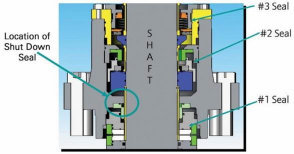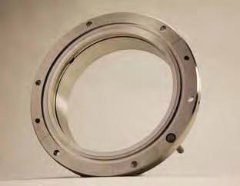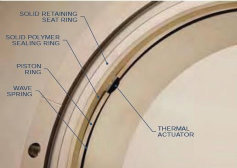Westinghouse developed the SHIELD® passive thermal shutdown seal as a passive means of protecting the reactor core. It prevents a loss of reactor coolant system (RCS) water inventory should an event occur that causes a loss of all seal cooling. The SHIELD passive thermal shutdown seal is proven to significantly reduce or eliminate leakage from the reactor coolant pump (RCP) seal with no operator action, power or control logic required.
The SHIELD passive thermal shutdown seal is a passive system that does not rely on operator action, power, control logic or cooling support systems. When the SHIELD passive thermal shutdown seal has been installed, operators do not need to implement an immediate cooldown to address RCP seal leakage at the onset of a station blackout event and, thus, are able to focus their efforts on critical tasks such as power recovery and maintaining a heat sink.
The SHIELD passive thermal shutdown seal offers a lead time from “decision to make improvement” to “implementation of solution” that is a fraction of the time and effort of alternate seal cooling systems. It also permits changes to deterministically derived station blackout and fire-coping strategies.
The SHIELD passive thermal shutdown seal improves mitigating system performance index (MSPI) margin by reducing RCP seal cooling vulnerabilities and decreasing core damage frequency by up to 50 percent.
In the event of a loss of all seal cooling in the RCP, the cool water between the pump impeller and the seal package will be displaced by hot RCS water. A loss of all RCP seal cooling requires the loss of both the thermal barrier heat exchanger (component cooling water) and RCP seal injection (charging pump, which sometimes is cooled by component cooling water). As the RCS fluid temperature rises, the seal leak-off is expected
to increase to 21 gpm (79.5 L/min). The SHIELD passive thermal shutdown seal mitigation of RCS inventory loss protects the core by maintaining fluid for a natural recirculation cooldown.
The following regulatory applications may be improved by installing the SHIELD passive thermal shutdown seal:
The SHIELD passive thermal shutdown seal is located above the RCP number 1 seal, recessed in the flange of the number 1 insert.

Location of SHIELD passive thermal shutdown seal
U.S. Nuclear Regulatory Commission (NRC) approved the final safety evaluation for the SHIELD probabilistic risk assessment (PRA) model. The approval is in addition to previously approved 1 week survivability of the SHIELD passive thermal shutdown seal under station blackout (SBO) conditions for regulatory applications. It is also applicable for extended loss of AC power (ELAP) and flexible mitigation strategies (FLEX). The SHIELD passive thermal shutdown seal flow limit of less than 1 gpm (3.8 L/min) also addresses the need for supplemental makeup for compliance with the NRC’s 10CFR50 Appendix R – Fire Protection regulation.

SHIELD passive thermal shutdown seal installed in modified number 1 insert

Detailed view with SHIELD passive thermal shutdown seal components identified
Additionally, the SHIELD passive thermal shutdown seal response time supports easy-to-implement fire protection strategies for National Fire Protection Association Standard NFPA 805 requirements.